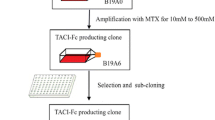Abstract
Objectives
To identify transcription markers that uniquely determine specific Chinese hamster ovary (CHO) cell lines and can be used for the identification of cell lines in the process of biopharmaceutical cell-line development.
Results
Five CHO cell lines with different origins were extensively characterised at the transcriptomic level and the results were compared to their karyotype characterisation. The analysed cell lines differ in their karyotype but, due to the genome instability observed during parental and recombinant cell-line establishment, karyotyping is not the preferred method for accurate identification of the various CHO cell lines. Marker genes unique to a specific cell line were identified by microarrays, and their expression was validated by reverse-transcription quantitative real-time PCR. The analysed cell lines can be differentiated by the presence/absence of detectable marker gene expression. Additionally, the similarity of the transcriptional profiles is dependent on cell-line history but independent of the manipulation steps involved in the recombinant cell-line development process.
Conclusions
Certain transcripts can be used as markers for the identification of a CHO cell line undergoing recombinant development and thus represent a powerful tool for ensuring the maintenance of high quality standards.





Similar content being viewed by others
References
Baker KE, Parker R (2004) Nonsense-mediated mRNA decay: terminating erroneous gene expression. Curr Opin Cell Biol 16:293–299
Cao Y, Kimura S, Itoi T, Honda K, Ohtake H, Omasa T (2012) Construction of BAC-based physical map and analysis of chromosome rearrangement in Chinese hamster ovary cell lines. Biotechnol Bioeng 109:1357–1367
Chusainow J, Yang YS, Yeo JH, Toh PC, Asvadi P, Wong NS, Yap MG (2009) A study of monoclonal antibody-producing CHO cell lines: what makes a stable high producer? Biotechnol Bioeng 102:1182–1196
Datta P, Linhardt RJ, Sharfstein ST (2013) An ‘omics approach towards CHO cell engineering. Biotechnol Bioeng 110:1255–1271
Goler-Baron V, Selitrennik M, Barkai O, Haimovich G, Lotan R, Choder M (2008) Transcription in the nucleus and mRNA decay in the cytoplasm are coupled processes. Gene Dev 22:2022–2027
Jostock T (2011) Expression of antibody in mammalian cells. In: Al-Rubeai M (ed) Antibody expression and production. Cell engineering, vol 7. Springer, Heidelberg, pp 1–24
Kao FT, Puck TT (1968) Genetics of somatic mammalian cells, VII. Induction and isolation of nutritional mutants in Chinese hamster cells. Proc Natl Acad Sci USA 60:1275–1281
Lewis NE et al (2013) Genomic landscapes of Chinese hamster ovary cell lines as revealed by the Cricetulus griseus draft genome. Nat Biotechnol 31:759–765
Maia BM, Rocha RM, Calin GA (2014) Clinical significance of the interaction between non-coding RNAs and the epigenetics machinery: challenges and opportunities in oncology. Epigenetics 9:75–80
Puck TT, Cieciura SJ, Robinson A (1958) Genetics of somatic mammalian cells. III. Long-term cultivation of euploid cells from human and animal subjects. J Exp Med 108:945–956
Urlaub G, Chasin LA (1980) Isolation of Chinese hamster cell mutants deficient in dihydrofolate reductase activity. Proc Natl Acad Sci USA 77:4216–4220
Urlaub G, Kas E, Carothers AM, Chasin LA (1983) Deletion of the diploid dihydrofolate reductase locus from cultured mammalian cells. Cell 33:405–412
Worton RG, Ho CC, Duff C (1977) Chromosome stability in CHO cells. Somat Cell Genet 3:27–45
Wurm F (2013) CHO Quasispecies—implications for manufacturing processes. Processes 1:296–311
Wurm FM, Hacker D (2011) First CHO genome. Nat Biotechnol 29:718–720
Xu X et al (2011) The genomic sequence of the Chinese hamster ovary (CHO)-K1 cell line. Nat Biotechnol 29:735–741
Acknowledgments
We would like to thank Dr. Holger Laux and his team for their hospitality and assistance during our visit to their laboratory. We are grateful to Katja Glinšek for her technical assistance in the karyotype analysis.
Supporting information
Supplementary Table 1—List of genes and their descriptions with the primer and probe sequences.
Supplementary Table 2—Summary of the RT-qPCR results for the genes indentified with unique expression for an individual cell line, from the data given in Fig. 5.
Supplementary Table 3—Quantitative real-time PCR analysis performed on genomic DNA isolated from the parental cell line samples.
Author information
Authors and Affiliations
Corresponding author
Electronic supplementary material
Below is the link to the electronic supplementary material.
Rights and permissions
About this article
Cite this article
Blas, M., Francky, A., Jamnikar, U. et al. Transcriptomic variation between different Chinese hamster ovary cell lines. Biotechnol Lett 37, 1737–1745 (2015). https://doi.org/10.1007/s10529-015-1850-0
Received:
Accepted:
Published:
Issue Date:
DOI: https://doi.org/10.1007/s10529-015-1850-0




